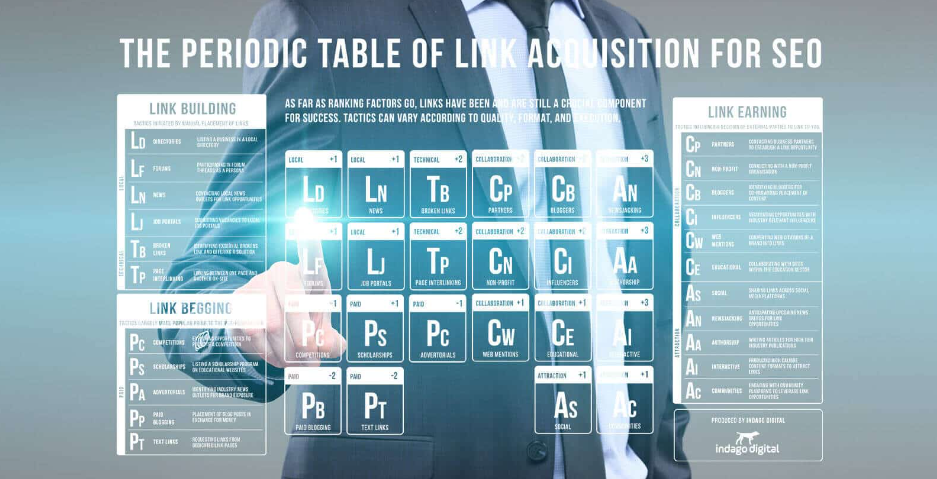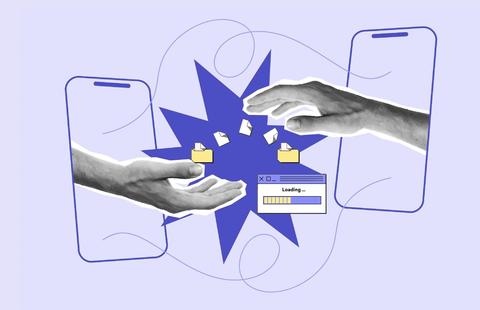
Indago Digital has launched an independent review of the current scope of link-building tactics used in the marketplace of link-building, setting the weak apart from the strong and breaking down those problematic grey areas in between. This visual guide – framed as a periodic table – is a subtle nod to the templates presented on SEO success factors from Search Engine Land and Content Marketing from Econsultancy, as well as other lesser-known examples.
Guidelines on Google’s own Webmaster Blog remind us that basing a strategy around link building, although a pivotal asset as a ranking factor, is not to be executed without purpose and that assembling a portfolio of links for the sake of it can have a detrimental impact on the performance of the website they are pointing to.
The focus of link value has shifted from sheer quantity to relevance and trust of the site linking out. Through the materiality of contextual content, user experience, mobile integration, localisation, and personalisation of search into the mix, it becomes evident that marketers have other ranking factors to be mindful of. Some experts may argue that a website can type without links. However, the ranking difficulty will vary from one industry to the next. Hence, the theory was put forward.
It’s fair to claim that the best link strategy should only target sites where you naturally expect a link to appear. This is why brands are activating content as the vehicle to contextualise the process naturally, out with the spam and in with the relationship building, where a link is purely a by-product of a great opportunity explored. Where link begging is perceived as old hat, link earning has taken power.
There is no set playbook to educate brands on how to transcend from the former to the latter, and this leap in application led us to introduce a classification system for the range of tactics.
The table’s goal and philosophy
Our goal with the Periodic Table of Link Building is to help publishers focus on the fundamentals needed to succeed by engaging with contextually relevant websites.
We searched the archives to collate all favoured link-begging, building, and earning tactics cited by industry experts. The list referenced the advice of Moz, Jon Cooper and Neil Patel, to name but a few. We quickly realised that although these guides dominated search results, the tactics had gathered a lot of dust and offered little perspective on what clear direction a brand should move towards to gain the edge in 2017 (and beyond).
We then stepped in to recall tactics used by SEO and content geniuses at Indago Digital in our past and present roles. We underscored those we felt had offered success by directly impacting traffic or visibility. And so these attributes acted as the reference point for how we decided on which methods made the Periodic Table cut.
What the link-building table covers
There are three major classes of factors:
- Link begging: These factors are prevalent during the pre-Penguin update era and may be susceptible to penalisation.
- Link building: These are factors one party initiates to influence another party to accept links for good purposes.
- Link earning: These are factors influenced by others or not directly tied to a publisher’s site.
Within these three classes are five categories of factors, which are:
- Paid — Factors relating to the content and quality of your material.
- Local — Factors about your overall site functionality.
- Technical — Factors specific to web pages.
- Collaboration — Factors related to how trustworthy and authoritative a site seems.
- Attraction — Factors related to how links impact rankings.
Going against the grain, we agreed upon not defining content as a tactic for link-building based on the vagueness of intent. Content without placement or promotional strategy can unexpectedly lead publishers down a rabbit hole. Links arrive in all shapes and sizes, although choosing a content format to attract or earn the link is a standard approach.
Overall, there are 22 individual factors in our table, ranging from text links in low-value community websites to producing high-calibre interactive content referenced by the media. Here’s a close-up of the table, focusing on just the factors:

How to understand the table
Each factor is assigned a two-letter symbol. The first letter corresponds to the category the factor is part of, such as “C” for Collaboration. The second letter represents the tactic itself, such as “i” for Influencers – therefore a symbol status of “Ci”.
As with the previous examples of the periodic table model we mentioned earlier, each factor also has a quality score. This is a subjective ruling from Indago Digital regarding how important it is to include one element over another. Despite some factors ranking as a minus score, we had them for their historical relevance to link building. In contrast, those scored +1, +2, and +3 are within the realms of strategy that Indago believes to have greater importance.
Let’s not rule out that the factors can work side by side or that no single factor applies to all those who try. From experience, we hypothesise that several factors working together, no matter how scarcely they are implemented, can tip the balance in your favour.
Factors with little SEO relevance
Pb: Paid blogging — Payment in exchange for a guest post inclusive of a link is still significant, with “link brokers” operating VPNs connecting hundreds and sometimes thousands of links in a database. Google’s official line is to avoid payment and earn your link organically. For this reason, the tactic scores poorly.
Pc: Paid competitions — If planting a match on an external site in the hope of a backlink, precautions should be taken – Google recommends following said link, which automatically devalues the process. Again, it is a low-scoring endeavour.
Pa: Paid advertorials — As with both tactics above, paying for the placement of a promotional story for SEO is not looked at fondly by Google. Unless stated clearly, this tactic may harm your site.
Here’s a quick reminder of what Google thinks about selling and buying links that pass page rank.
Factors with moderate SEO relevance
Ld: Local directories— Local business listings and citations can help influence reputation, rankings, and revenue, as stated in this guide. The value ultimately depends on how well the website linking to you is performing technically.
Ln: Local news — Links via local news sites can manifest as stories, job listings, or business notifications. Used wisely, local news sites can be a handy asset for links.
Tb: Broken links — If the link you are searching for no longer exists, call up the webmaster and request to have your content placed there instead. This tactic feels outdated, although some experts still advise seeing it through.
Tp: Page interlinking — Linking from one internal page to another can pass through page authority and ranking power. It’s also pivotal for aiding website navigation and defining the architecture and hierarchy of a website.
Factors with potential for SEO success
Cm: Web mentions — A strong marketing campaign will naturally generate mentions about the brand online, and these opportunities should be capitalised on by the brand requesting for the site to embed a link where appropriate. Regular high-tier citations can fuel an ongoing link strategy.
Cp: Partners — Leveraging your relationship with well-known businesses presents the opportunity not only to be referenced on their site but also to co-promote content and offers on external sites. The bigger the partner, the more excellent the link opportunity.
Cb: Bloggers — A blogger may naturally want to write about your latest product. However, opportunities such as giveaways and product reviews for referral traffic and social engagement can also be explored. When working with bloggers, the rewards can be high, and so too can the risk. Google demands that bloggers disclose the relationship, use no-follow tags, and produce compelling content in all instances to stamp out spammy tactics.
An: Newsjacking — Engaging with editors and reporters is the gateway to publishing your stories online, with the possibility of a link citing you as the source. This tactic is as powerful as press release distribution once was. Many specialists consider stories led by data as a successful method for obtaining links.
Aa: Authorship — Building your reputation as a writer means you may be presented with offers to contribute to highly influential sites, the likes of Forbes, Mashable and TechCrunch. Authors have a responsibility to provide value to the reader but also dictate which links may be used within their material. Acceptance is understandably rigorous to fend off link scheme tactics.
Ai: Interactive — Interactive is today’s static infographic. And the tactic is broad enough for brands to find a style that carries their message to the consumer. Popular choices of interactive content for link earning span from quizzes to podcasts, webinars, calculators, and maps. Due to the person-hours needed to perfect an interactive content piece, the expectations are far greater than other link tactics – and will also push for inbound traffic and social engagement. Ideas, advice, and case studies can be found here.
At Indago Digital, we believe that each link acquisition tactic has a place and that the stuff we refer to as traditional link building is the fundamentals for a long-term roadmap. The sexy bits like data-driven content and interactive storytelling, which take time, patience and additional resources to plan and execute, should come into play after the low-hanging fruit has been plucked. But once they are on the web, they may be referenced and linked to repeatedly.
Written by
Lewis Torossian





